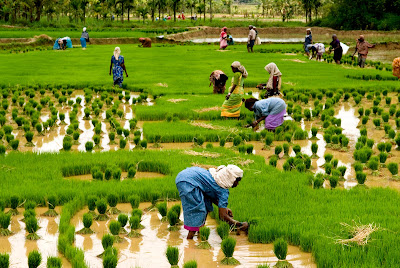Planting the Seeds of a Real "Green Revolution"
From Al Jazeera, comes this video on how roughly �two million farmers in the Indian state of Andhra Pradesh have ditched chemical pesticides in favour of natural repellants and fertilisers, as part of a growing eco-agriculture movement.� This represents, I think, agricultural production (pardon the pun) �on the ground,� in a literal and figurative sense in contrast to hyper-industrialized capitalist agriculture, as an eminently rational process of political economy and ecology (thus, political ecology) beyond the impoverished assumptions of Malthusian Social Darwinism, the political premises of messianic neo-imperialism, and the Promethean promises of bio-technology (recall, for instance, the extent to which America�s export[1] of plant-breeding science was an integral part of the Cold War�s defense of capitalist political economics and economy and the �battle for freedom�). In other words, the original Green Revolution, as John H. Perkins argued in Geopolitics and the Green Revolution: Wheat, Genes, and the Cold War (Oxford University Press, 1997) was an unmitigated �success� only in terms of �an increase in the aggregate physical supply of grain,� and the policies that promoted the new forms of plant-breeding, soil fertility science and hydrologic development were not motivated in the first place by humanitarian considerations (although it did not hurt to rhetorically craft their public rationale in such terms), particularly when we appreciate the fact that questions of distributive justice and political power essential to the explanation of hunger and malnutrition (not to mention famines) were ideologically buried (cf. �food for peace�) in the political and economic policies (and, we came to learn, ecologically pernicious effects) of the Green Revolution�s[2] myopic and blinkered focus on population growth rates and aggregate food supplies. In the words of Raj Patel, �a technological solution muffled a political problem.� The political economy of the Green Revolution has proven intransigent: �India has...destroyed millions of tons of grains, permitting food to rot in silos, while the quality of food eaten by India�s poor is getting worse for the first time since Independence in 1947.�[3] Alternatives to the Green Revolution have taken root in India, particularly in the Indian state of Kerala:
�Rather than engaging in a technological fix, Kerala opted for a political solution, beginning with the 1957 Land Reform Ordinance and Education Bill. [....] Land redistribution was brought together as a policy package with public food distribution programmes, employment guarantees, education and healthcare systems, under the administration of the state-led Communist government. The package worked and has led today to the highest levels of literacy, health status and social development in the country, even though Kerala�s population of 30 million is on average poorer than the average citizen elsewhere in India.�[4]
Notes:
[1] Central here is the role of the Rockefeller and Ford Foundations often working in conjunction with agencies like the World Bank and the U.S. Agency for International Development (USAID).
[2] See, for example, Vandana Shiva�s The Violence of the Green Revolution (Zed Books & Third World Network, 1991).
[3] Raj Patel, Stuffed and Starved: The Hidden Battle for the World�s Food System (Melville House Publishing, 2007): p. 3.
[4] Ibid., p. 127. See too, Sen�s well-known discussion of Kerala�s development as exemplifying a �very rapid reduction[] in in mortality rates and enhancement of living conditions, without much economic growth,� in his Development as Freedom (Alfred A. Knopf, 1999). As David A Crocker writes in Ethics of Global Development: Agency, Capability, and Deliberative Democracy (Cambridge University Press, 2008), along with Porto Alegre, Brazil, Kerala has become �iconic of deliberative and democratic development.� On the Communists of Kerala, see Michelle Williams, The Roots of Participatory Democracy: Democratic Communists in South Africa and Kerala, India (Palgrave Macmillan, 2008).


Comments
Post a Comment